engine SUZUKI CELERIO 2022 Owner's Manual
[x] Cancel search | Manufacturer: SUZUKI, Model Year: 2022, Model line: CELERIO, Model: SUZUKI CELERIO 2022Pages: 201, PDF Size: 5.82 MB
Page 72 of 201
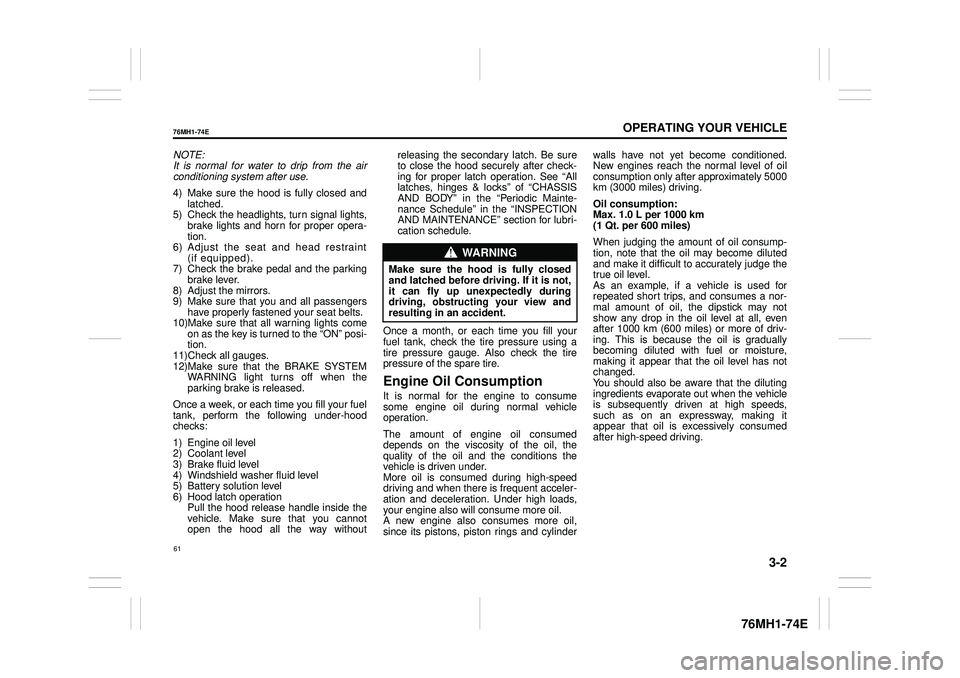
3-2
OPERATING YOUR VEHICLE
76MH1-74E
76MH1-74E
NOTE: It is normal for water to drip from the air conditioning system after use.
4) Make sure the hood is fully closed and latched.5) Check the headlights, turn signal lights, brake lights and horn for proper opera- tion.6) Adjust the seat and head restraint (if equipped). 7) Check the brake pedal and the parkingbrake lever. 8) Adjust the mirrors. 9) Make sure that you and all passengershave properly fastened your seat belts. 10)Make sure that all warning lights come on as the key is turned to the “ON” posi-tion. 11)Check all gauges. 12)Make sure that the BRAKE SYSTEMWARNING light turns off when the parking brake is released.
Once a week, or each time you fill your fuel tank, perform the following under-hood checks:
1) Engine oil level 2) Coolant level3) Brake fluid level 4) Windshield washer fluid level 5) Battery solution level6) Hood latch operation Pull the hood release handle inside the vehicle. Make sure that you cannotopen the hood all the way without
releasing the secondary latch. Be sure to close the hood securely after check- ing for proper latch operation. See “Alllatches, hinges & locks” of “CHASSIS AND BODY” in the “Periodic Mainte- nance Schedule” in the “INSPECTIONAND MAINTENANCE” section for lubri- cation schedule.
Once a month, or each time you fill your fuel tank, check the tire pressure using a tire pressure gauge. Also check the tirepressure of the spare tire.
Engine Oil Consumption
It is normal for the engine to consume some engine oil during normal vehicle operation.
The amount of engine oil consumed depends on the viscosity of the oil, thequality of the oil and the conditions the vehicle is driven under. More oil is consumed during high-speeddriving and when there is frequent acceler- ation and deceleration. Under high loads, your engine also will consume more oil.A new engine also consumes more oil, since its pistons, piston rings and cylinder
walls have not yet become conditioned. New engines reach the normal level of oil consumption only after approximately 5000km (3000 miles) driving.
Oil consumption: Max. 1.0 L per 1000 km (1 Qt. per 600 miles)
When judging the amount of oil consump- tion, note that the oil may become diluted and make it difficult to accurately judge thetrue oil level. As an example, if a vehicle is used for repeated short trips, and consumes a nor-mal amount of oil, the dipstick may not show any drop in the oil level at all, even after 1000 km (600 miles) or more of driv-ing. This is because the oil is gradually becoming diluted with fuel or moisture, making it appear that the oil level has notchanged. You should also be aware that the diluting ingredients evaporate out when the vehicleis subsequently driven at high speeds, such as on an expressway, making it appear that oil is excessively consumedafter high-speed driving.
WA R N I N G
Make sure the hood is fully closed and latched before driv ing. If it is not, it can fly up unexpectedly duringdriving, obstructing your view and resulting in an accident.
61
Page 73 of 201
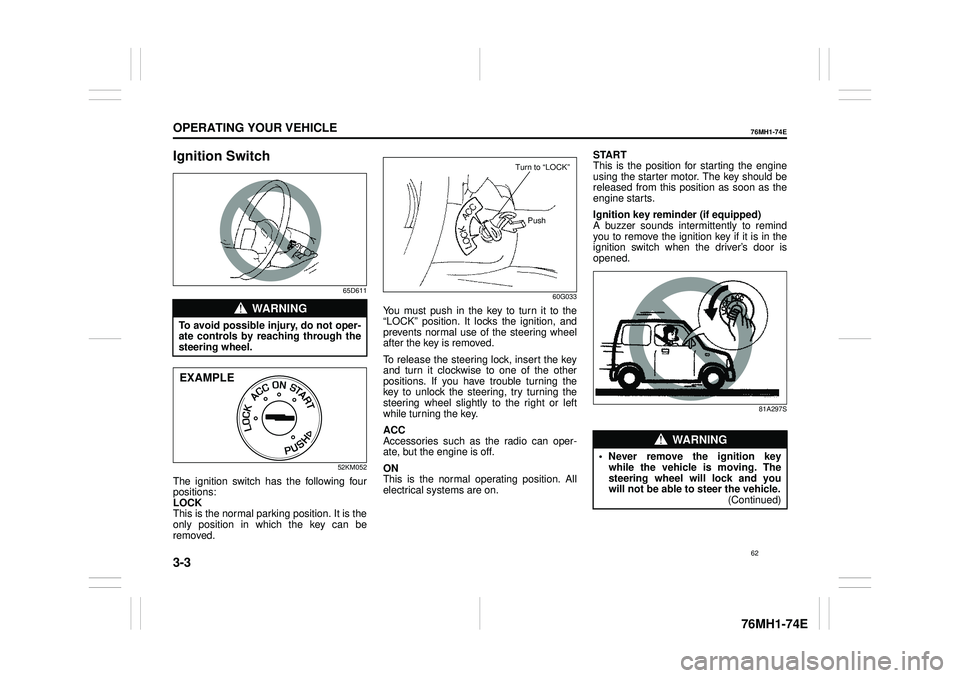
3-3
OPERATING YOUR VEHICLE
76MH1-74E
76MH1-74E
Ignition Switch
65D611
52KM052
The ignition switch has the following four positions: LOCK This is the normal parking position. It is theonly position in which the key can be removed.
60G033
You must push in the key to turn it to the “LOCK” position. It lo cks the ignition, and prevents normal use of the steering wheel after the key is removed.
To release the steering lock, insert the key and turn it clockwise to one of the other positions. If you have trouble turning thekey to unlock the steering, try turning the steering wheel slightly to the right or left while turning the key.
ACC Accessories such as the radio can oper-ate, but the engine is off.
ON This is the normal operating position. All electrical systems are on.
START This is the position for starting the engine using the starter motor. The key should bereleased from this position as soon as the engine starts.
Ignition key reminder (if equipped) A buzzer sounds intermittently to remind you to remove the ignition key if it is in theignition switch when the driver’s door is opened.
81A297S
WA R N I N G
To avoid possible injury, do not oper- ate controls by reaching through thesteering wheel.
EXAMPLE
Turn to “LOCK”
Push
WA R N I N G
• Never remove the ignition keywhile the vehicle is moving. The steering wheel will lock and you will not be able to steer the vehicle.(Continued)
62
Page 74 of 201
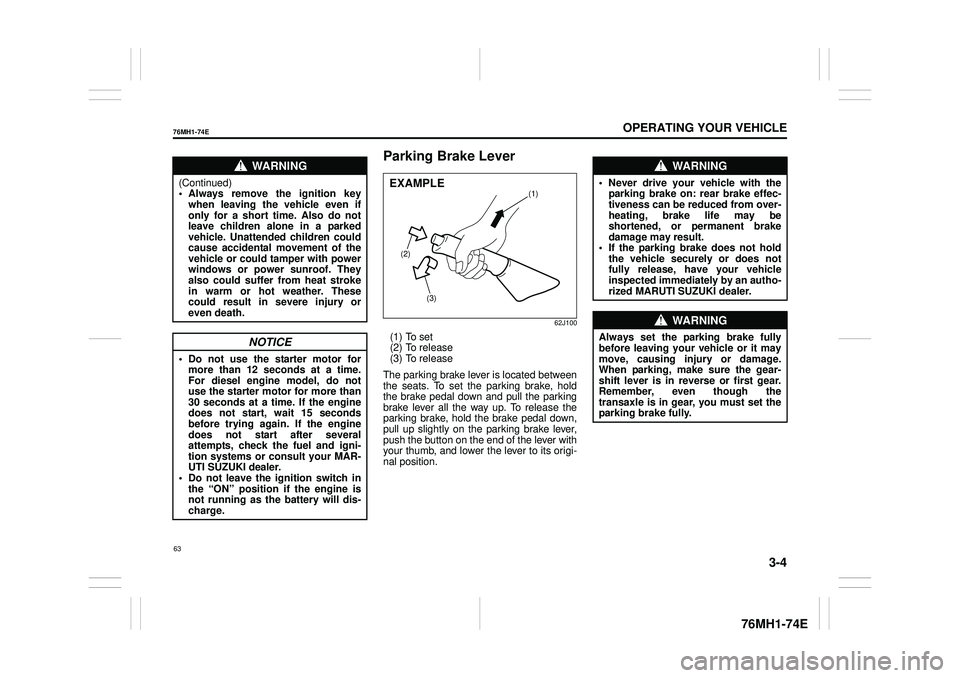
3-4
OPERATING YOUR VEHICLE
76MH1-74E
76MH1-74E
Parking Brake Lever
62J100
(1) To set (2) To release(3) To release
The parking brake lever is located between the seats. To set the parking brake, hold the brake pedal down and pull the parking brake lever all the way up. To release theparking brake, hold the brake pedal down, pull up slightly on the parking brake lever, push the button on the end of the lever withyour thumb, and lower the lever to its origi- nal position.
WA R N I N G
(Continued) • Always remove the ignition keywhen leaving the vehicle even if only for a short time. Also do not leave children alone in a parkedvehicle. Unattended children could cause accidental movement of the vehicle or could tamper with powerwindows or power sunroof. They also could suffer from heat stroke in warm or hot weather. Thesecould result in severe injury or even death.
NOTICE
• Do not use the starter motor for more than 12 seconds at a time.For diesel engine model, do not use the starter motor for more than 30 seconds at a time. If the enginedoes not start, wait 15 seconds before trying again. If the engine does not start after severalattempts, check the fuel and igni- tion systems or consult your MAR- UTI SUZUKI dealer.• Do not leave the ignition switch in the “ON” position if the engine is not running as the battery will dis-charge.
(2)
(3)
(1)EXAMPLE
WA R N I N G
• Never drive your vehicle with theparking brake on: rear brake effec-tiveness can be reduced from over- heating, brake life may be shortened, or permanent brakedamage may result. • If the parking brake does not hold the vehicle securely or does notfully release, have your vehicle inspected immediately by an autho- rized MARUTI SUZUKI dealer.
WA R N I N G
Always set the pa rking brake fully before leaving your vehicle or it may move, causing injury or damage. When parking, make sure the gear-shift lever is in reverse or first gear. Remember, even though the transaxle is in gear, you must set theparking brake fully.
63
Page 75 of 201

3-5
OPERATING YOUR VEHICLE
76MH1-74E
76MH1-74E
NOTE: (For Auto Gear Shift Model)For details on how to use the gearshift lever to park the vehicle, refer to “Parking” in “Auto Gear Shift” in this section.
Parking Brake Reminder Buzzer (if
equipped)A buzzer sounds intermittently to remind you to release the parking brake if youstart the vehicle without releasing the park- ing brake. Make sure that the parking brake is fully released and the brake sys-tem warning light turns off.
Pedal
Manual transaxle
80J2121
Auto Gear Shift
80J2122
Clutch Pedal (1)
(For manual transaxle)The clutch pedal is used to disengage the drive to the wheels when starting theengine, stopping, or shifting the gearshift lever. Depressing the pedal disengages the clutch.
Brake Pedal (2)Your MARUTI SUZUKI vehicle is equipped with front disc brakes and rear drum brakes. Depressing the brake pedalapplies both sets of brakes.
You may hear occasional brake squeal when you apply the brakes. This is a nor- mal condition caused by environmental factors such as co ld, wet, snow, etc.
WA R N I N G
When parking the vehicle in extremely cold weather, the followingprocedure should be used: 1) Set the parking brake. 2) Manual transaxl e - turn off the engine, then shift into reverse or first gear. Auto Gear Shift – shift into reverseor first gear and check the gear position indicato r in the instru- ment cluster to ma ke sure that the transaxle is engaged in 1st or reverse, then turn off the engine. 3) Get out of the vehicle and putchocks under the wheels. 4) Release the parking brake. When you return to your vehicle,you must remember to first set the parking brake, then remove the wheel chocks.
(2)(1)
(3)
EXAMPLE
(3)
(2)
EXAMPLE
WA R N I N G
Do not drive with your foot resting onthe clutch pedal. It could result inexcessive clutch wear, clutch dam- age, or unexpected loss of engine braking.
WA R N I N G
If brake squeal is excessive andoccurs each time the brakes areapplied, you should have the brakes checked by your MARUTI SUZUKI dealer.
64
Page 76 of 201

3-6
OPERATING YOUR VEHICLE
76MH1-74E
76MH1-74E
Accelerator Pedal (3)This pedal controls the speed of the engine. Depressing the accelerator pedal increases power output and speed.
Starting the Engine
Before Starting the Engine
76MH021
1) Make sure the parking brake is set fully.2) Manual transaxle
Page 77 of 201

3-7
OPERATING YOUR VEHICLE
76MH1-74E
76MH1-74E
Restarting diesel engine after fuel- empty stopIf the engine stops and the low fuel warn- ing light and the malfunction indicator light come on, use the following procedure:1) Fill the fuel tank. 2) Hold the ignition key in
Page 78 of 201
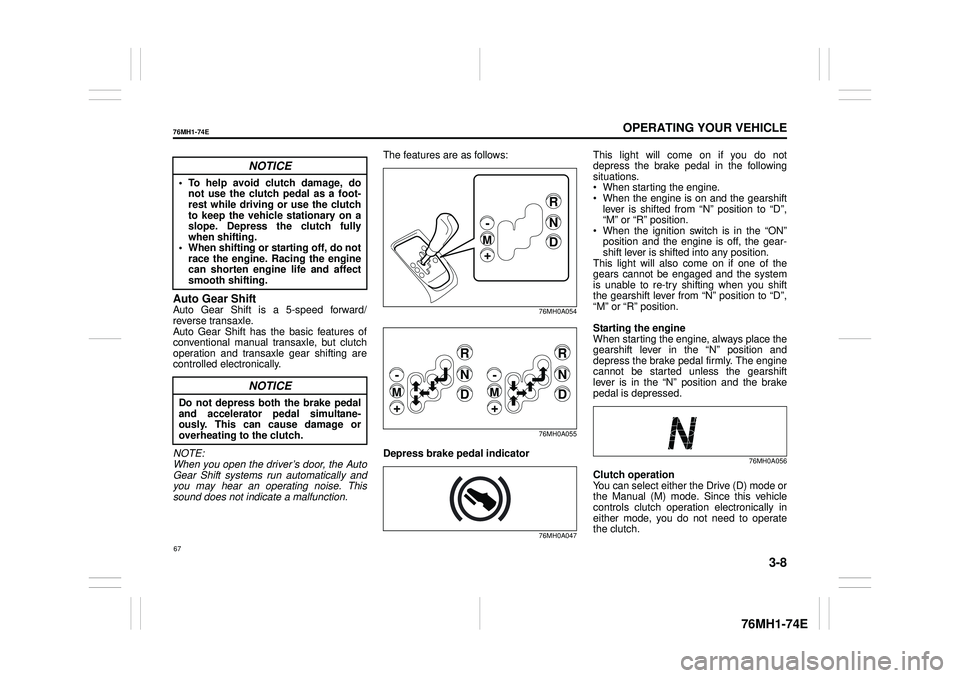
3-8
OPERATING YOUR VEHICLE
76MH1-74E
76MH1-74E
Auto Gear ShiftAuto Gear Shift is a 5-speed forward/ reverse transaxle. Auto Gear Shift has the basic features of conventional manual transaxle, but clutchoperation and transaxle gear shifting are controlled electronically.
NOTE: When you open the driver’s door, the Auto Gear Shift systems run automatically and you may hear an operating noise. Thissound does not indicate a malfunction.
The features are as follows:
76MH0A054
76MH0A055
Depress brake pedal indicator
76MH0A047
This light will come on if you do not depress the brake pedal in the following situations. When starting the engine. When the engine is on and the gearshift lever is shifted from “N” position to “D”,“M” or “R” position. When the ignition switch is in the “ON” position and the engine is off, the gear-shift lever is shifte d into any position. This light will also come on if one of the gears cannot be engaged and the systemis unable to re-try shifting when you shift the gearshift lever from “N” position to “D”, “M” or “R” position.
Starting the engine When starting the engine, always place thegearshift lever in the “N” position and depress the brake pedal firmly. The engine cannot be started unless the gearshiftlever is in the “N” position and the brake pedal is depressed.
76MH0A056
Clutch operationYou can select either the Drive (D) mode or the Manual (M) mode. Since this vehiclecontrols clutch operation electronically in either mode, you do not need to operate the clutch.
NOTICE
• To help avoid clutch damage, donot use the clutch pedal as a foot-rest while driving or use the clutch to keep the vehicle stationary on a slope. Depress the clutch fullywhen shifting. • When shifting or starting off, do not race the engine. Racing the enginecan shorten engine life and affect smooth shifting.
NOTICE
Do not depress both the brake pedaland accelerator pedal simultane- ously. This can cause damage oroverheating to the clutch.
R
N
D
-
M
+
R
N
D
-
M
+
R
N
D
-
M
+
67
Page 79 of 201

3-9
OPERATING YOUR VEHICLE
76MH1-74E
76MH1-74E
Creeping function This vehicle has a creeping function that helps the vehicle to start smoothly byengaging the clutch. When the gearshift lever is in any of the positions “D”, “M” or “R”, and you release your foot from thebrake pedal, the vehicle starts slowly with- out depressing the accelerator pedal. The creeping function is disabled if you depressthe brake pedal or pull up the parking brake lever.
NOTE: If the driver’s door is opened and/or the parking brake lever is engaged with thegear in the “M”, “D” or “R” position, the creeping function will not operate.
Parking and Stopping the vehicle Auto Gear Shift does not have a parking position. The vehicle can be parked withthe gearshift lever in any position. When stopping the vehicle, the gear will be shifted to 1st.
Drive (D) mode When the Drive (D) mode is activated, the most appropriate gear position is automati- cally selected upon operation of the accel- erator pedal and variation of vehicle speed.
Normal driving: 1) Start the engine as instructed in
Page 80 of 201
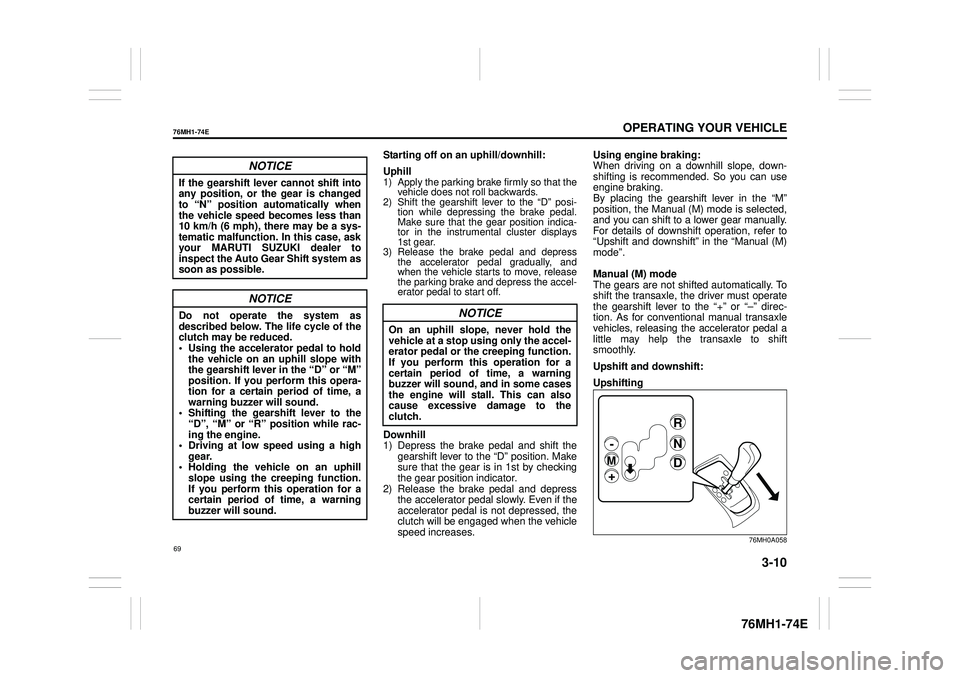
3-10
OPERATING YOUR VEHICLE
76MH1-74E
76MH1-74E
Starting off on an uphill/downhill:
Uphill1) Apply the parking brake firmly so that the vehicle does not roll backwards.2) Shift the gearshift lever to the “D” posi-tion while depressing the brake pedal.Make sure that the gear position indica-tor in the instrumental cluster displays1st gear. 3) Release the brake pedal and depress the accelerator pedal gradually, andwhen the vehicle starts to move, releasethe parking brake and depress the accel-erator pedal to start off.
Downhill 1) Depress the brake pedal and shift the gearshift lever to the “D” position. Make sure that the gear is in 1st by checkingthe gear position indicator. 2) Release the brake pedal and depress the accelerator pedal slowly. Even if theaccelerator pedal is not depressed, the clutch will be engaged when the vehicle speed increases.
Using engine braking: When driving on a downhill slope, down- shifting is recommended. So you can useengine braking. By placing the gearshift lever in the “M” position, the Manual (M) mode is selected,and you can shift to a lower gear manually. For details of downshift operation, refer to “Upshift and downshift” in the “Manual (M)mode”.
Manual (M) mode The gears are not shifted automatically. To shift the transaxle, the driver must operate the gearshift lever to the “+” or “–” direc-tion. As for conventional manual transaxle vehicles, releasing the accelerator pedal a little may help the transaxle to shift smoothly.
Upshift and downshift:
Upshifting
76MH0A058
NOTICE
If the gearshift lever cannot shift into any position, or the gear is changedto “N” position automatically when the vehicle speed becomes less than 10 km/h (6 mph), there may be a sys-tematic malfunction. In this case, ask your MARUTI SUZUKI dealer to inspect the Auto Gear Shift system assoon as possible.
NOTICE
Do not operate the system as described below. The life cycle of the clutch may be reduced.• Using the accelerator pedal to hold the vehicle on an uphill slope with the gearshift lever in the “D” or “M”position. If you perform this opera- tion for a certain period of time, a warning buzzer will sound.• Shifting the gearsh ift lever to the “D”, “M” or “R” position while rac- ing the engine.• Driving at low speed using a high gear. • Holding the vehicle on an uphillslope using the creeping function. If you perform this operation for a certain period of time, a warningbuzzer will sound.
NOTICE
On an uphill slope, never hold thevehicle at a stop using only the accel-erator pedal or the creeping function. If you perform this operation for a certain period of time, a warningbuzzer will sound, and in some cases the engine will stall. This can also cause excessive damage to theclutch.R
N
D
-
M
+
69
Page 81 of 201
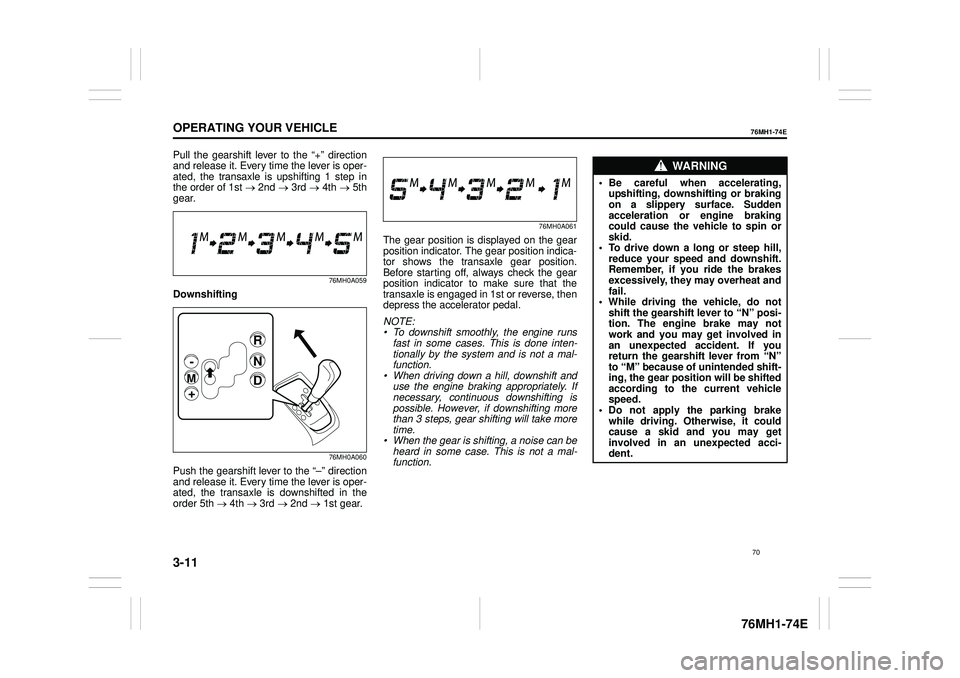
3-11
OPERATING YOUR VEHICLE
76MH1-74E
76MH1-74E
Pull the gearshift lever to the “+” direction and release it. Every time the lever is oper- ated, the transaxle is upshifting 1 step inthe order of 1st 2nd 3rd 4th 5th gear.
76MH0A059
Downshifting
76MH0A060
Push the gearshift lever to the “–” directionand release it. Every time the lever is oper- ated, the transaxle is downshifted in theorder 5th 4th 3rd 2nd 1st gear.
76MH0A061
The gear position is displayed on the gear position indicator. The gear position indica- tor shows the transaxle gear position.Before starting off, always check the gear position indicator to make sure that the transaxle is engaged in 1st or reverse, thendepress the accelerator pedal.
NOTE: • To downshift smoothly, the engine runs fast in some cases. This is done inten- tionally by the system and is not a mal-function. • When driving down a hill, downshift and use the engine braking appropriately. Ifnecessary, continuous downshifting is possible. However, if downshifting more than 3 steps, gear shifting will take moretime. • When the gear is shifting, a noise can be heard in some case. This is not a mal-function.
R
N
D
-
M
+
WA R N I N G
• Be careful when accelerating,upshifting, downshifting or brakingon a slippery surface. Sudden acceleration or engine braking could cause the vehicle to spin orskid. • To drive down a long or steep hill, reduce your speed and downshift.Remember, if you ride the brakes excessively, they may overheat and fail.• While driving the vehicle, do not shift the gearshift lever to “N” posi- tion. The engine brake may notwork and you may get involved in an unexpected accident. If you return the gearshif t lever from “N” to “M” because of unintended shift- ing, the gear position will be shifted according to the current vehiclespeed. • Do not apply the parking brake while driving. Otherwise, it couldcause a skid and you may get involved in an unexpected acci- dent.
70